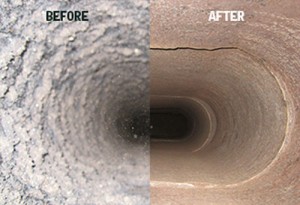Cleaning Creosote from Your Chimney
If you use a fireplace, unfortunately there is no escape from creosote. Every time wood is burned in the fireplace, creosote builds up on the chimney liner. For this very purpose, it is recommended to have a fireplace and chimney inspected annually—preferably in the off season when it is not in use and before using it again.
What Is Creosote?
Creosote is a tar-like, black, sooty, and flammable substance. It appears in three stages. The first stage being the easiest to clean and the third stage being incredibly dangerous and hard to remove.
First Stage Creosote
When creosote is in the first stage, it looks like a flaky soot. This happens when the flue was filled with cold air and then warmed by the fire’s heat. A chimney sweep will have no problem cleaning creosote at this level with a basic chimney brush.
Second Stage Creosote
Second stage creosote develops when the chimney has a restricted amount of air flow—usually seen on fireplaces with glass doors. This creosote appears as hard, shiny black flakes. The flakes contain hardened tar that is not so easy to remove. At this stage a chimney sweep will most likely have to use a rotary loop to remove the creosote. This is a powerful drill that turns metal rods and performs well against the tarry residue.
Third Stage Creosote
A homeowner who uses their fireplace frequently will want to avoid ever reaching this stage. Third stage creosote is not only incredibly difficult to remove, but it is also a dangerous, concentrated fuel. At this point it will appear like a thick coat of tar is dripping down the inside of the chimney flue. It will continue to glaze over the previous layer and harden until removed, and if it is not, it can easily be ignited by a fire in the fireplace.
Chimney cleaning is highly important to avoid reaching this stage and to prevent a chimney fire from occurring. If creosote is allowed to reach this level, a chimney sweep will either use chemicals to clean it or will recommend replacing the chimney liner all together.
How to Minimize Creosote Buildup
In order to build up a minimum amount of creosote with each fireplace use, try to follow these tips.
- Burn hot, clean fires instead of slow-burning, smoldering fires, which produce a greater amount of combustion by-products in the chimney.
- Burn only seasoned firewood. This is wood that has been allowed to dry out for 6 to 12 months so the moisture level is low.
- Do not burn artificial logs, which leave behind creosote in the chimney.
- Ensure that the chimney flue is properly connected to any heating appliances.
- Open the flue damper completely to avoid letting the fire smolder.
Resources: Chimney Solutions
More Helpful Articles:
Does Your Chimney Liner Need Replacing
Chimney Masonry Problems That Could Jeopardize Safety
Is Your Firewood Seasoned?
Wells & Sons Chimney Service offers a full range of chimney cleaning services to the Allentown, Norristown, Lansdale, Pottstown, Berwyn, Boyertown, and surrounding PA areas. Chimney cleaning services include levels 1 thru 3 chimney inspections and chimney sweeps using a high-velocity ROVAC vacuum.









